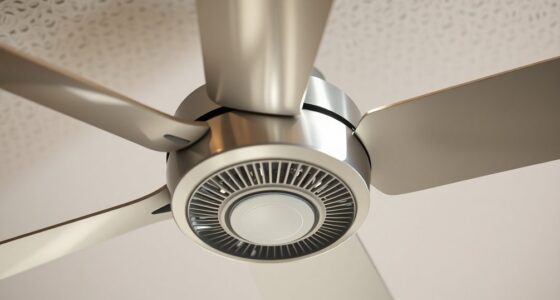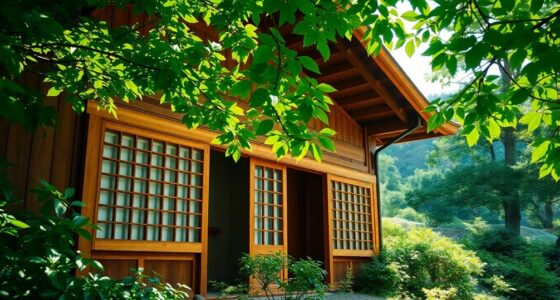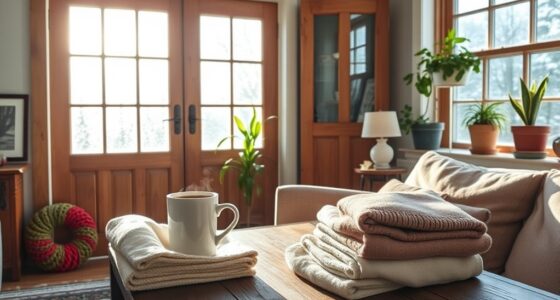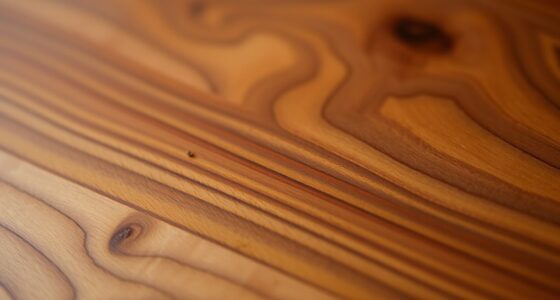Yes, you can build brick houses in America, but it's not as straightforward as it sounds. While brick offers durability and aesthetic appeal, rising labor costs and complex installation methods make it a pricier option compared to other materials. Environmental concerns also come into play, as brick production is energy-intensive and can lead to significant carbon emissions. Furthermore, many places are moving towards more sustainable alternatives. While brick has historical significance and regional charm, you might want to take into account other building materials too. There's more to explore about the future and benefits of brick construction.
Key Takeaways
- Yes, you can build brick houses in America, but costs and labor complexities are higher than alternative materials like wood-frame construction.
- The declining popularity of brick is influenced by rising labor costs and limited local sources of brick.
- Brick offers durability, energy efficiency, and low maintenance, but can face issues like cracks in extreme weather.
- Innovative techniques are being developed to enhance brick sustainability, making it a viable option for future construction.
- Historical preservation efforts support the continued demand for brick, particularly in urban areas where it holds aesthetic value.
Current Trends in Brick Construction
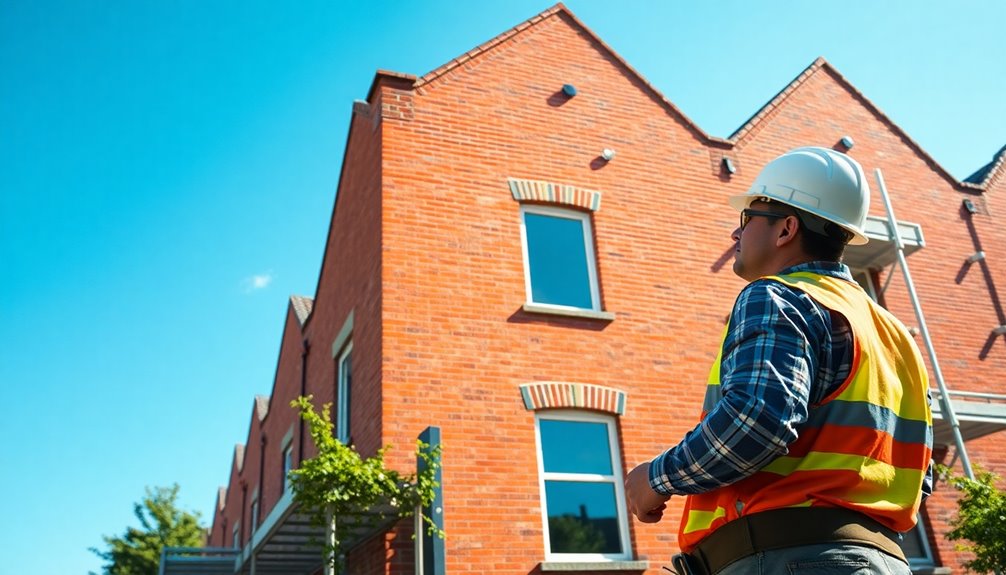
As the construction industry evolves, you might notice that brick is facing stiff competition from lighter, more cost-effective materials like wood and steel.
Current trends in brick construction show a decline in popularity since the post-WWII era, largely due to the higher labor costs and installation complexities associated with brick. For instance, the average cost of brick siding for a 2,500 sq ft home is around $18,000, making it pricier compared to modern alternatives.
Additionally, relaxed building codes have decreased the demand for masonry skills, further impacting brick's use in new projects.
Despite these challenges, brick remains appealing for its durability, aesthetic charm, and low maintenance, and environmental concerns are sparking renewed interest in this timeless building material.
Economic Factors Affecting Brick Use
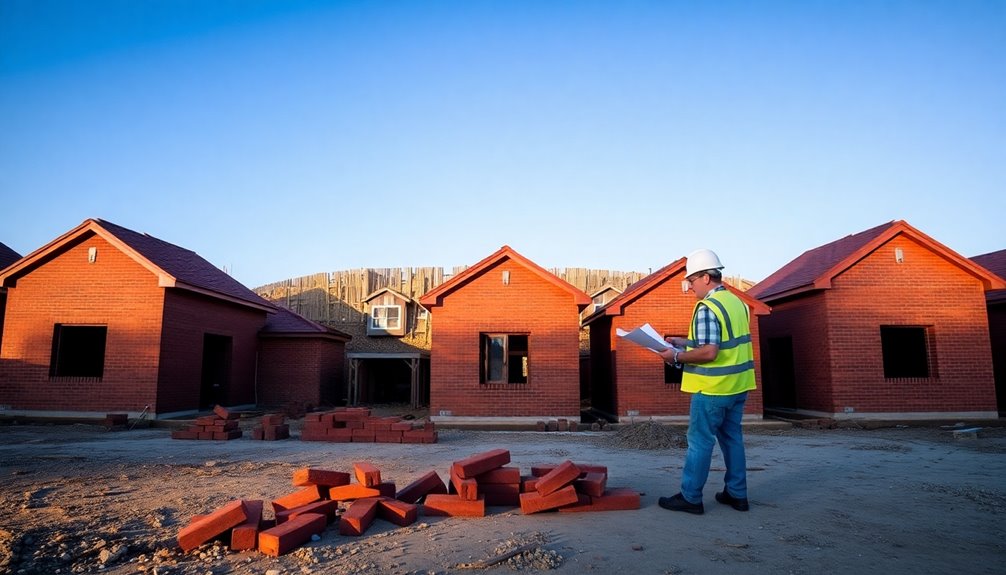
While many homeowners appreciate the charm of brick, economic factors greatly influence its use in construction today. The cost of masonry construction can reach up to three times more than wood-frame construction, which averages about $18 per square foot.
After World War II, the demand for quicker and cheaper building methods led to a decline in brick homes. Today, builders face economic challenges like increasing labor costs and dwindling local brick sources.
Additionally, historical building methods favoring brick construction are often restricted by current codes, raising costs further. Major homebuilders also contend with lawsuits due to construction flaws, emphasizing the economic risks tied to poor material choices.
These factors combine to limit the use of brick as a building material.
Environmental Impacts of Brick Building
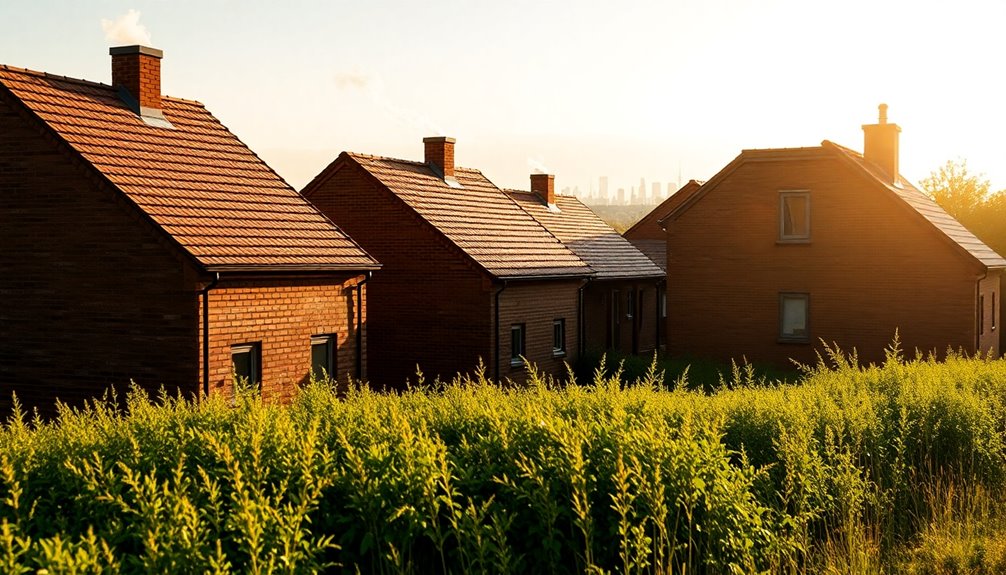
Economic factors greatly limit the use of brick in construction, but it's also important to take into account the environmental impacts of this material. The production of brick involves energy-intensive processes that release significant carbon dioxide emissions, contributing to climate change. Additionally, diminishing local clay sources raise concerns about sustainability.
| Impact Type | Description | Sustainability Score |
|---|---|---|
| Carbon Emissions | High from kiln firing using fossil fuels | Low |
| Resource Depletion | Limited local clay availability | Medium |
| Energy Consumption | Brick production is energy-intensive | Low |
| Durability | Long-lasting but contributes to carbon footprint | Medium |
Transitioning to more sustainable materials like wood can help minimize these environmental impacts in construction.
Benefits of Using Brick
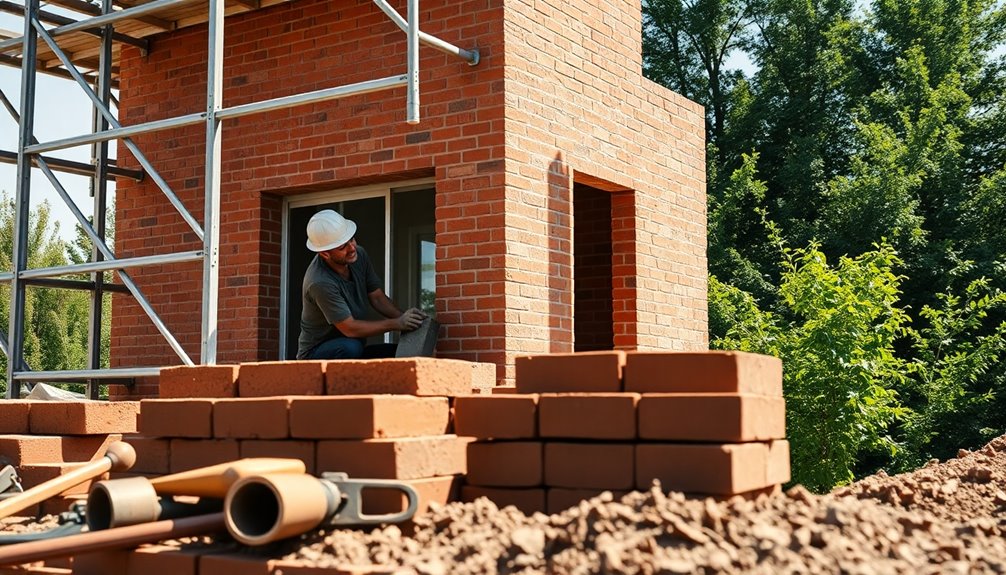
When you choose brick for your construction, you're investing in a material known for its impressive durability and long lifespan.
Not only does brick stand strong against the elements, but it also offers energy efficiency that can keep your indoor temperatures comfortable year-round.
This combination makes brick an excellent choice for a sustainable and low-maintenance home.
Durability and Longevity
As you consider building or renovating your home, the durability and longevity of materials play an essential role in your decision-making process.
Brick walls stand out for their exceptional resilience, often lasting indefinitely due to their resistance to mold, rot, and mildew. This makes them suitable for various climates, including humid areas.
Additionally, bricks are fire-resistant, adding safety to your investment. Their low maintenance requirements mean you won't have to worry about fading or deterioration over time, making them a smart long-term choice.
Historically, brick structures have shown impressive resilience against extreme weather events, underscoring their reliability.
Choosing brick offers you peace of mind, knowing you've selected a material built to endure. Furthermore, just like hydrogen fuel cells, brick construction contributes to sustainable building practices by minimizing the environmental impact over time.
Energy Efficiency Advantages
While you might focus on aesthetics when choosing materials for your home, energy efficiency is another essential factor that shouldn't be overlooked.
Brick homes offer superior thermal mass, allowing them to maintain stable indoor temperatures effectively. This high heat capacity means brick homes are nearly double as efficient as wood-framed houses, helping you save on energy bills for heating and cooling.
Additionally, the durability of brick results in a long lifespan and minimal maintenance, translating to cost savings over time.
With excellent insulation properties, brick structures reduce energy consumption and enhance your comfort levels.
Drawbacks of Brick Homes
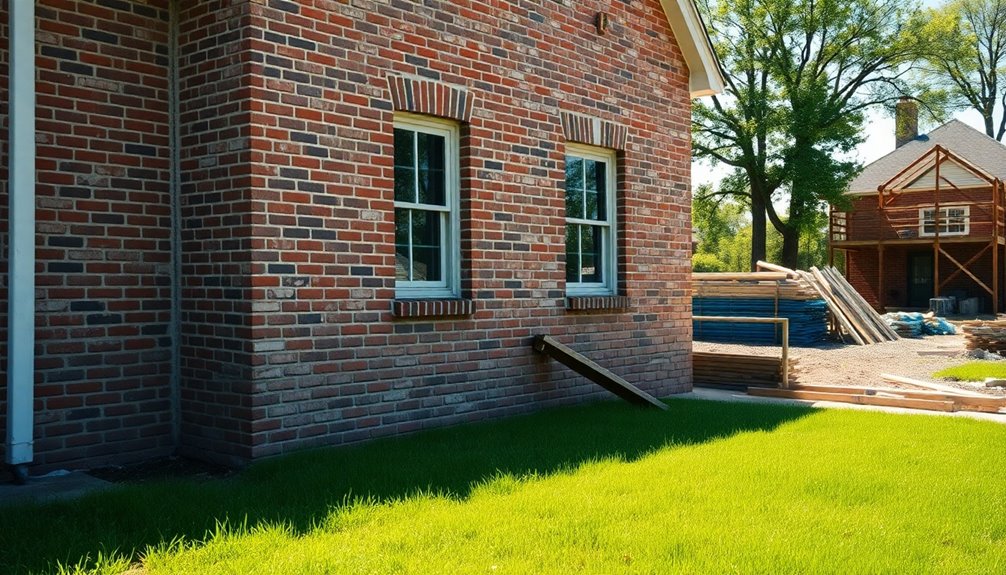
Despite their aesthetic appeal and durability, brick homes come with several drawbacks that potential buyers should consider.
One major issue is the initial construction costs, which can be up to three times higher than wood frame homes, making them less accessible. Additionally, the installation and repair of brick structures are labor-intensive, leading to increased maintenance costs over time.
Brick's rigidity also poses challenges in adapting to climate changes, causing cracks in earthquake-prone areas. Moreover, moisture vulnerability is a significant concern; the porous nature of bricks can trap moisture, resulting in mold and mildew.
Once damage occurs, repairs can be costly and complicated, often requiring extensive work compared to alternative materials that allow for quicker, less expensive fixes. Furthermore, homeowners should be aware that repairing brick structures can be particularly challenging, as specialized skills and tools are often needed for effective restoration.
Comparison With Alternative Materials
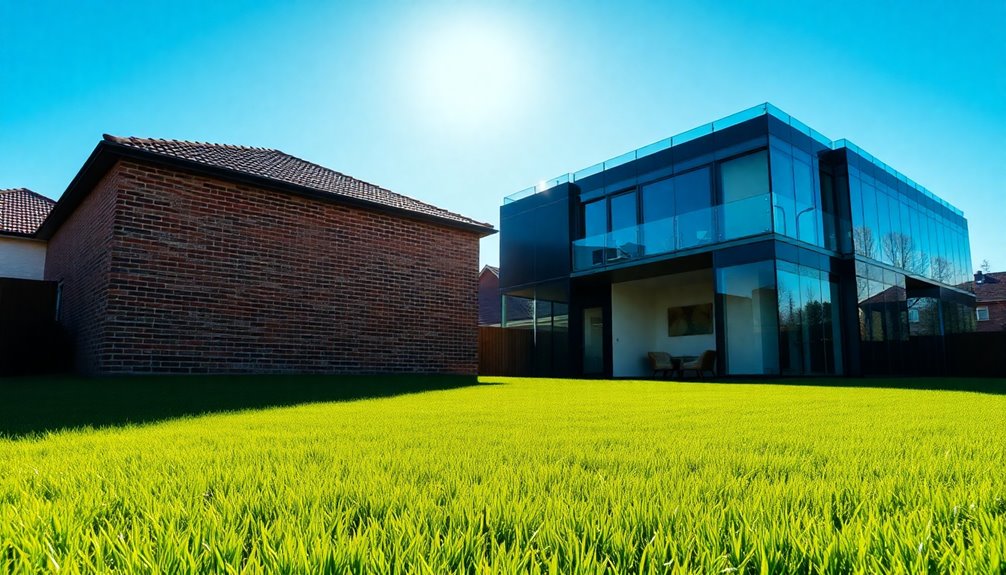
When you weigh your options for building materials, cost is a major factor to evaluate.
While brick boasts durability, alternatives like wood and fiber cement often offer lower prices and quicker installation.
Additionally, the environmental impact of your choice can influence not just the budget but also the sustainability of your project.
Cost Considerations and Impacts
Building a home involves weighing several cost considerations, especially when comparing traditional materials like wood and brick.
The cost to build brick houses can be around three times more than wood frame construction, which averages about $18 per square foot. This higher initial cost comes from needing skilled masons and the complexity of brickwork.
While brick homes typically offer lower maintenance needs, repairs can be more expensive and intricate, ultimately leading to higher long-term costs.
Additionally, building codes may differ, adding to expenses. With economic shifts, many now prefer less expensive materials like steel and wood, further impacting the popularity of brick homes.
Ultimately, you must evaluate these cost factors carefully before making your decision.
Sustainability and Environmental Effects
Although many homeowners appreciate the durability of brick, its environmental impact raises concerns compared to alternative materials like wood.
Brick production involves significant carbon dioxide emissions due to the firing process in kilns, making it less sustainable. In contrast, wood acts as a carbon sink and reduces transportation emissions, enhancing its eco-friendliness.
While brick offers longevity, it doesn't align with LEED certification goals that focus on minimizing the carbon footprint throughout a building's lifecycle.
As local brick sources dwindle and regulations tighten, the construction industry is increasingly turning to eco-friendly materials like fiber cement. This shift reflects a growing awareness of sustainability and the need for construction practices with a lower environmental impact. Additionally, the use of heat pumps in new buildings can further reduce energy consumption and emissions, promoting a more sustainable construction approach.
Durability and Maintenance Challenges
While brick is often chosen for its aesthetic appeal and longevity, its durability comes with significant maintenance challenges that can complicate homeownership.
Brick's rigid structure makes it less adaptable to temperature changes, leading to cracks and potential structural failures during extreme weather. Additionally, its porous nature can trap moisture, creating moisture-related issues like mold growth, which aren't as prevalent with alternative materials like fiber cement siding.
While brick requires costly repairs involving multiple bricks and mortar replacement, fiber cement is quicker and more affordable to install.
Ultimately, despite its long-lasting qualities, the maintenance challenges associated with brick often push builders toward more flexible and moisture-resistant options in modern construction.
Historical Significance of Brick

Brick has been a cornerstone of American construction since ancient civilizations laid the groundwork for durable architecture. Its historical significance is evident, as brick homes have stood the test of time, showcasing their resilience.
The industrial revolution propelled brick production, making it a favored choice during the post-war housing boom. Today, you can see the architectural heritage that brick represents in urban areas, where preservation efforts highlight its cultural importance.
The lower maintenance requirements of brick homes compared to wooden structures further contribute to their lasting presence. Various styles, such as Flemish bonds and soldier courses, reflect regional characteristics, emphasizing the diverse and rich history of brick in America.
This durability and significance make brick an enduring symbol of American architecture.
Regional Variations in Brick Usage
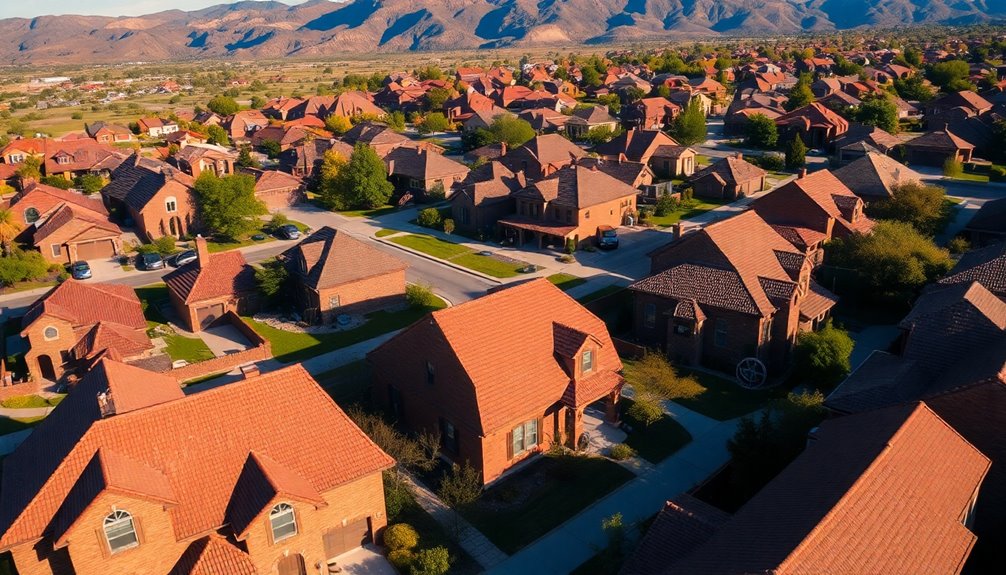
As you explore the diverse landscape of American architecture, you'll notice that regional variations in brick usage reveal much about local history and culture.
In urban areas, brick houses are popular due to their lower maintenance and higher resale value. The Northeast and Midwest showcase unique styles like Flemish bonds, reflecting their architectural traditions.
The availability of clay deposits also varies, influencing the quality and characteristics of local bricks. The post-war housing boom led to a spike in brick construction, especially in suburban regions.
However, environmental regulations and diminishing local brick sources have impacted this trend, pushing some areas to adopt alternative materials for new builds.
Understanding these regional differences enhances your appreciation of America's architectural diversity.
Future of Brick in Construction
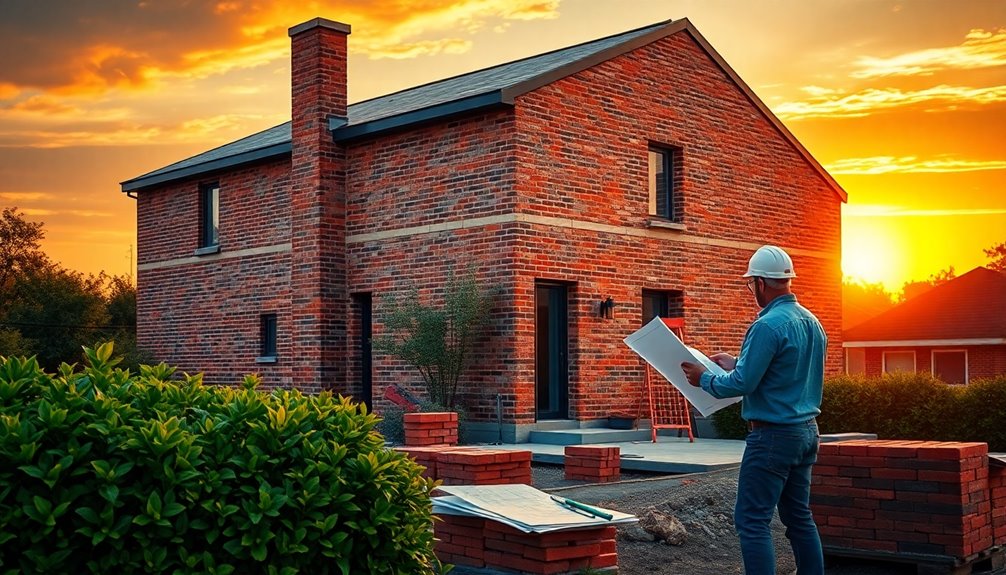
Regional variations in brick usage have shaped the architectural landscape, but the future of brick construction is poised for transformation. As you explore new construction trends, consider the following:
- Innovative techniques enhance brick's sustainability.
- Hybrid materials blend brick with other durable options.
- Historical preservation boosts demand for traditional aesthetics.
- Rising costs of alternatives make brick a cost-effective choice.
Advancements in materials science are paving the way for brick's resurgence, making it not just a classic option but also a modern solution. In light of environmental concerns, builders are increasingly recognizing the importance of sustainable building practices, including the recyclability and longevity of brick.
With environmental concerns driving builders to reconsider their choices, brick's recyclability and longevity position it as a sustainable choice for the future.
Embracing these developments can help you create homes that balance durability with the charm of traditional aesthetics.
Frequently Asked Questions
Can You Build a House With Bricks in the USA?
Yes, you can definitely build a house with bricks in the USA.
Brick construction offers durability and low maintenance, making it a great choice. While initial costs might be higher than wood, you'll appreciate the long-term benefits, like energy efficiency and stable indoor temperatures.
Plus, many regions have local clay deposits, which support both your project and the local economy.
Why Are Houses in the US Not Built With Bricks?
You might wonder why houses in the U.S. aren't often built with bricks. The answer lies in cost and practicality.
Brick construction can be expensive, costing around $54 per square foot compared to about $18 for wood. After WWII, builders shifted to quicker, cheaper materials to meet suburban demands.
Plus, modern codes and fewer local brick sources make brick less appealing. While durable, the high initial costs deter many from choosing brick for new homes.
What Are the Disadvantages of a Brick House?
When considering a brick house, you'll notice some disadvantages. Higher initial costs can put a strain on your budget, and repairs often turn into time-consuming, expensive projects.
The rigidity of brick makes it vulnerable to cracks from temperature changes, while its porous nature can trap moisture, leading to mold issues.
Plus, the heavy weight of brick might require stronger foundations, further increasing your construction expenses compared to lighter materials.
Why Aren T Brick Buildings Built Anymore?
In today's fast-paced world, it's clear why brick buildings aren't as common anymore.
You'll find that the high costs associated with brick construction, combined with the demand for quicker, cheaper materials, greatly sway builders' choices.
Modern aesthetics and relaxed building codes have further contributed to this decline.
Additionally, the environmental impact of brick manufacturing and the expensive repairs needed for brick structures discourage many from opting for this traditional method.
Conclusion
So, can you build brick houses in America? Absolutely, but it's not as straightforward as it seems. While brick offers durability and aesthetic appeal, economic factors and environmental concerns often steer builders toward alternatives like wood or concrete. Curiously, many regions with a rich brick history still embrace it, challenging the notion that brick is outdated. As sustainability becomes a priority, brick could make a comeback, blending tradition with modern eco-friendly innovations in construction.


